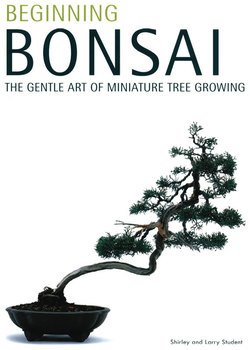Читать книгу Beginning Bonsai - Larry Student - Страница 8
На сайте Литреса книга снята с продажи.
ОглавлениеBonsai is the Oriental art of creating miniature versions of nature's wondrous trees; it is the reproduction, on a small scale, not only of the dwarf trees of the mountains but also of the giant trees of the forests.
In ancient China naturally dwarf trees were collected from mountainous areas and revered throughout the country. The trees were potted in beautiful, highly decorated containers and enjoyed as "artistic pot plants," as they were then called. It is thought that little else was done to the trees to keep them alive other than attending to their basic horticultural needs. These "artistic pot plants" were kept behind palace walls for the ruling classes.
Over the centuries much of China's culture was sent to Japan. The Japanese absorbed and refined this culture, which included elements of religion, government, architecture, and the "artistic pot plants" that were sent to Japan as gifts for the aristocracy. These plants might have remained behind palace walls had not Chinese monks introduced them to the public as they taught Zen Buddhism to the common people. The miniature trees were ideal teachers of philosophical principles concerning the harmony of nature, man's place in the universe, and the harmonious blending of heaven, earth, and man. From this beginning, bonsai emerged as the horticultural art form we practice and study today.
Unlike the wealthy man, the common man could not travel to the mountains to collect trees. He had to rely on whatever was easily obtained, the trees and seedlings near his home or at the outskirts of his town or village. To these young trees he collected, he began to apply what he had seen nature do to trees over the years. He observed the wonders of nature that created strong, old trees, sometimes showing beauty, often dignity and character, and always the ability to survive.
The working class, who first saw the wonder of dwarf trees, soon began to establish the elementary guidelines of what would become a sophisticated horticultural art form. From that time on, the art of bonsai would be continually studied and expanded by its masters and their followers.
Bonsai, as we know it today, evolved from its Chinese origins into an art form that produced smaller, more refined trees. Chinese gardens were loose, free, expansive. Their "artistic pot plants" reflected that horticultural approach. On the other hand, Japanese gardening was more precise, contained, and refined. Moreover, because the space for living and the time for gardening for ordinary Japanese were limited, their tree designs and containers became smaller and more refined. In Japan, the tokonoma, a small ceremonial alcove, became an important part of every home. Trees were brought into the house and placed in the tokonoma for short periods of time.
In the past, as now, the primary concern was to keep the trees alive and healthy after they were root pruned and planted in shallow pots. The development of tree design and style would evolve slowly, but from early on, the trees that were used were small and young, and the artistic goal was to create the illusion of an old tree with strength and character.
Oriental philosophy and religion taught that the world was ordered yet asymmetrical. The concepts of heaven, earth, and man, fitting within a triangle, brought peace and harmony to daily life. These concepts formed the basis for many art forms, including bonsai. Nature's work was not to be copied exactly but to be reproduced in miniature. Unlike nature, man does not create big trees; but as in nature, man's work on his "created" tree is never complete. Each tree, whether tiny or large, is a unique creation, ever changing.
Stories are told of trees being passed down from generation to generation, a tradition recognizing man's imperfections and humble reverence for nature. A single man would not presume to think he had perfected or completed the development of a tree in a single lifetime. The study of bonsai in this book derives from the teachings of generations of masters who have spent their lives acquiring horticultural knowledge as it merged with the art of designing miniature trees.
Today the artistry and technique of bonsai are universal. With the spread of bonsai throughout the world, many species of trees from many countries have become proper subjects for bonsai. Bonsai belongs to everyone.
As you approach the study of bonsai, know that you and your trees will change. You will bring your own feelings and artistry to bonsai. The goal of your first venture into bonsai should be to learn the techniques of the art—hands on, step by step, tree by tree. Strive always for the harmony of heart, mind, and hand.
After World War II, our returning servicemen spoke with wonder and awe of beautiful Japanese trees hundreds of years old, growing in shallow pots. As it was with them, may you too be caught up in the beauty of your own miniature trees and never get over the mystery and romance of bonsai.
FIG. 2 Miniature bonsai are 10" or under. You can grow a number of them even when space is limited.
